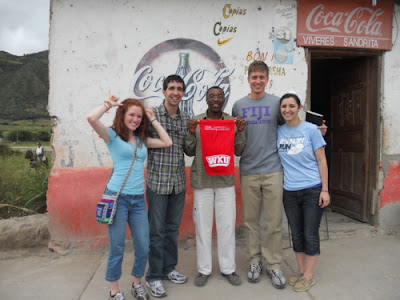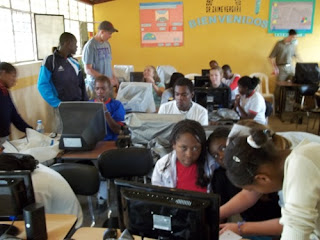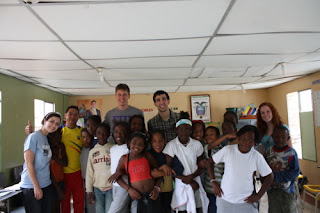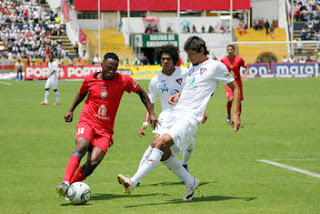Author Archives: Partners
Day 7 – Chillin’
Day 6 – Una Minga
 We’ll be making our third and final trip to Santa Ana Sunday to present them with the computers that we brought with us. The training has taken place in nearby Concepcion because the furniture company wasn’t able to deliver the proper equipment to hold the lessons in Santa Ana. However, next week, after we have returned to Quito, the town will be able to fully install the computers that the city of Bowling Green donated and Gene Iglehart programmed for them.
We’ll be making our third and final trip to Santa Ana Sunday to present them with the computers that we brought with us. The training has taken place in nearby Concepcion because the furniture company wasn’t able to deliver the proper equipment to hold the lessons in Santa Ana. However, next week, after we have returned to Quito, the town will be able to fully install the computers that the city of Bowling Green donated and Gene Iglehart programmed for them.As for me, I had one of the most humbling days of my life.
 |
| before |
 |
| after |
 |
| Wade Haga |
 |
| trago de caña, Ecuadorian moonshine |
Hand in hand, the men of Santa Ana and our team for the park project worked to erect this park that had existed in only our minds for months. There is an old word that dates back to ancient Andean culture for this called una minga. It means community work. My favorite interaction is when one of the local men offered us some trago de caña, otherwise known as moonshine, to speed the process along. As we hammered nails and screwed in screws, I couldn’t believe how tangible our dream had become. All the nights spent worrying about failure and all the scrapped plans seemed so distant as the kids started jumping on the columpios (swings) and resbaladeras (slides). It was impossible to believe this started as an idea to smuggle pieces of wood in our suitcases to build a couple of benches.
 Before we left, one of the men thanked us for coming and partnering with them. He told me that it meant so much to Santa Ana to have this opportunity. He closed by saying, “Siempre, las puertas de Santa Ana están abiertas a ustedes.” (Always, the doors of Santa Ana are open to you all.)
Before we left, one of the men thanked us for coming and partnering with them. He told me that it meant so much to Santa Ana to have this opportunity. He closed by saying, “Siempre, las puertas de Santa Ana están abiertas a ustedes.” (Always, the doors of Santa Ana are open to you all.)
He has no idea how thankful I am for the opportunity to help, though it didn’t stop me from trying to explain.
Ojalá que la gente de Santa Ana disfrutare este parque por siempre. [God willing, they will enjoy this park forever.]
Day 5 – Santa Ana: Projects Kick-off
|
“The computers were slow, so people were on different parts of the lesson,” he said. “Gmail thought we were running some sort of pyramid scheme, so we had to call to verify the accounts but didn’t have phones. The computers were programmed differently, and we didn’t get everything done the way we wanted.”
“But we know what to do for tomorrow’s lesson. We worked well today despite the problems. We learned how to adapt, and everyone was helping. We did really good considering all the problems.”
|
Even with the rough patches, Kyla Gwyn, a student at MTSU, said the day was a definite success for the weekend on the whole.
“We built relationships that will help us more than anything tomorrow. I know I got a lot more accomplished today towards the end when the people started feeling more comfortable with me, and I got to know them. We have two days, so really, today turned out great.”
 My group went to locate a specific place to build the playground set we ordered from Technoswiss tomorrow. We went alone with no interpreter, so my Spanish skills quickly sharpened as I met community leaders willing to help and conversed with the local kids in Santa Ana’s elementary school to get them excited about their new playground. Many of us played soccer or climbed on whatever we could find with them.
My group went to locate a specific place to build the playground set we ordered from Technoswiss tomorrow. We went alone with no interpreter, so my Spanish skills quickly sharpened as I met community leaders willing to help and conversed with the local kids in Santa Ana’s elementary school to get them excited about their new playground. Many of us played soccer or climbed on whatever we could find with them.Day 4 – Otavalo: Bread and Roses
 First and foremost, this bread was amazing. It was super buttery and warm, and we had it with some with a type of cheese called queso de hoja. Era sabroso. (It was delicious!)
First and foremost, this bread was amazing. It was super buttery and warm, and we had it with some with a type of cheese called queso de hoja. Era sabroso. (It was delicious!)
 |
| tour guide and rose farmer (left) |
We kept travelling north from the rose farm to Otavalo. On our way, we stopped in a small town called Pijal. We learned loads about traditional Ecuadorian herbal medicine from our tour guide there . She also shared with us a huge meal and the story of her cousin that was taken to Australia because her lack of education left her vulnerable. Unable to read, she struggled to escape the control of the woman that had taken her there from Quito. Finally, in a manner only capable by God to our guide, a woman freed her and took her to the United States and has taught her how to read. Now she is a very happy and visits Ecuador from time to time. Our guide looks at her cousin’s story as a source of inspiration and treated us to a dinner in her house to demonstrate her ambition to employ the people in Pijal . She makes complex embroideries and enjoys her work very much.
Day – 3 Playground Planning
 |
| Margarita Columba |
A special thanks must also go out to the Alive Center at WKU. We could not have done this project without your grant and help.
Day – 2 Exploring Quito
 Since I talked about it in the last post, I figured it would be best to start off with a picture that includes the backdrop of the city. I’m not sure the picture illustrates it as well as I’d like, but the city really does swim through the Andes mountains. It’s truly a sight to behold with all the buildings sprawling out like a rushing river through the valley. It also helps to see it from the top of a monestary roof here in Quito It may have been a bit dangerous climbing up there, but the view was worth it
Since I talked about it in the last post, I figured it would be best to start off with a picture that includes the backdrop of the city. I’m not sure the picture illustrates it as well as I’d like, but the city really does swim through the Andes mountains. It’s truly a sight to behold with all the buildings sprawling out like a rushing river through the valley. It also helps to see it from the top of a monestary roof here in Quito It may have been a bit dangerous climbing up there, but the view was worth it We did all of this as part of a tour of the historical part of Quito. It has such a rich history that our tour guide, Patricia, shared with us. She was the one that got us behind the scenes and on top of various roofs in Quito. The views were always amazing and the amazing amount of cultura (culture) never ceases to overwhelm me. I did manage to grasp a bit of it though as we visited a boutique that sold Panama hats. You may be wondering why Ecuador is selling Panama hats… It’s actually because those hats originated in Ecuador but were shipped out through Panama, thus giving them their misinformed name.
We did all of this as part of a tour of the historical part of Quito. It has such a rich history that our tour guide, Patricia, shared with us. She was the one that got us behind the scenes and on top of various roofs in Quito. The views were always amazing and the amazing amount of cultura (culture) never ceases to overwhelm me. I did manage to grasp a bit of it though as we visited a boutique that sold Panama hats. You may be wondering why Ecuador is selling Panama hats… It’s actually because those hats originated in Ecuador but were shipped out through Panama, thus giving them their misinformed name.Day 1 – Quito
Ambato and Canoa
On Sunday, February 13, our friend Leonardo drove us to Ambato, where we had been asked to join Lexington’s Dr. Henry Vasconez and his group of about 80 doctors and nurses. Their team would be performing plastic surgeries all week, and we would be applying fluoride varnish on kid’s teeth. Also, we had planned to go to the women’s prison. (When we were here with Beau Haddock and The Highland Rim in 1996, one facet of our program and video had been a report on this prison. Unless things have changed, when a woman with small children is imprisoned here, she must bring the children with her, then depend on family and friends to feed them. We had hoped to apply fluoride varnish and provide toothbrushes and beanie babies to these women and little ones).
Canoa is a small fishing village with a great beach and waves which break perfectly for surfing, drawing a lot of gringos here. When we say small, we mean about six blocks square. It would be impossible to get lost here. There are cliffs behind the town which are used by parasailers and hanggliders. Along the beach are many great restaurants and funky bars. Our two favorites were the Costa Azul (for great shrimp, calamari and ceviche), dinner for two with drink $9.50; and La Flor, a gringo restaurant, where the bartenders are both from Michigan and one and perhaps both (we were unsure) are married to the beautiful daughters of the owner-cook. The owner and the daughters are not Norteamericanas, but we were also unsure if they are Ecuadorian. In the event, the place is very eclectic, with cool music, a great vibe, terrific food, and they disinfect all the fresh veggies, so we could actually eat everything on the plate. And, is it good! Yum. Canoa is famous for having more hammocks per capita than any other place in Ecuador, so after a hard “hammock day”, (and after having had our luncheon calamari at Costa Azul), we would escape to the caring arms of La Flor.
One night at La Flor, we met a really nice guy from, of all places, London, KY. They told us he had come down for a visit 7 years ago, and just never went home. Like many Kentuckians, he hated winter there and felt he had found paradise. Is he wrong? I think not. His name is Greg Gilliam, and he is building a beautiful new hotel right on the beach, just at the end of the town’s development. He asked us to bring him an Ale-8-One next time we visit, so that is on our agenda. Also, the bar at La Flor sells whiskeys from the U.S., including Jim Beam. I said “But, I always heard that Jim Beam drinks Makers Mark”. So he showed us the now-empty bottle of M.M., the only evidence of how popular it truly had been, so we will definitely gift them with a bottle next year. Hey, we want all these folks to jump in and help with the fluoride varnish, and we learned a long time ago, that it is wise to “grease the wheels” in Ecuador; this will be money well spent.
We met with Elizabeth Stark, who owns a hotel next to La Vista and works with the James Dean Byrd Foundation, where she places volunteers to teach English and other subjects. She arranged for us to visit the local health clinic, where we trained the local dentist to place fluoride varnish and treated several kids and adults there. We then went to a government-run day care center and treated all the kids and adults there. (Had our large supply of varnish and brushes not been lost in transit to Ambato, we’d have had much more material to work with). We also handed out beanie babies and neon-colored bracelets with “Happy Molars” printed on them (we would occasionally see these throughout the town later) and school supplies.
Leonardo came on Saturday to spend the night, so we could get an early start back on Sunday morning. After dinner, we took a drive to San Vicente and then across the longest bridge in South America, just completed last November, to Bahia de Caragues. The trip to Bahia from San Vicente used to take 1 1/2 hours, as Bahia is located on a peninsula separated by the Chone River. Bahia is one of the cleanest towns in Ecuador and in 1999 declared itself an “Eco-City” because of its efforts to promote recycling, conservation and environmental awareness. This entire area from Canoa to Bahia is not to be missed.
The next morning, after a great breakfast at La Vista, we were off again, to be thrown back into the real world. Our memories will have to sustain us until we once again, hopefully this time next year, lie in that hammock and watch the beautiful, changing colors as the sun sets again over the Pacific.
—
Rankin and Ruthi
Futbol Fever
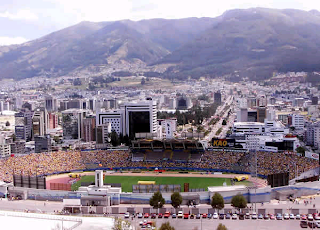 |
| Estadio Olimpico Atahualpa, Quito |
It was Sunday morning, and I awoke with butterflies in my stomach. One big difference in the cultures of South America and our home is that everyone here is passionate about futbol (soccer). They don’t so much like it, they seem to live for it. Leonardo, his 14-year-old son, his nephew and I had scored tickets for a playoff game for the national title between Nacional and Liga de Quito at the Estadio Olimpico Atahualpa. Even though we arrived two hours before game time, we still had to park about 2 miles away. Upon arrival at the stadium, I came to realize the fans are segregated according to their team of choice. In the end zones are the fanatics, with painted faces, everyone attired in their team colors. They have their own bands and spend the entire game dancing up and down in unison, singing and blowing whistles. It is hard to explain the excitement which accompanies a game like this; think the South African fans. As soon as we entered the stadium, we felt the electricity in the air. We arrived very early, but the stadium was already about 80% filled. By game time, there wasn’t a seat in the house. Just imagaine—the end zone gangs had everyone worked into a frenzy, and there were 45,000 screaming fans.

 The game actually started on time and right away I saw some of the best passing I had seen since the World Cup. The play was excellent and the defense was vicious. There were a total of 8 yellow cards. With 8 minutes left in the first half La Liga scored and the crowd went crazy. Of course, this got the opposing team started with the trash talk; we won’t get go into great detail about this as this blog is rated for a family audience.
The game actually started on time and right away I saw some of the best passing I had seen since the World Cup. The play was excellent and the defense was vicious. There were a total of 8 yellow cards. With 8 minutes left in the first half La Liga scored and the crowd went crazy. Of course, this got the opposing team started with the trash talk; we won’t get go into great detail about this as this blog is rated for a family audience. About ten minutes before the game ended, a swat team marched into the aisles between the two groups of fans. This is the only area of the stadium which is not surrounded by fences. The swat team shows up in full regalia—bullet-proof vests, helmets, shields and night sticks. These guys mean business! Each of the groups of fans had to exit the stadium through separate doors; then there were more cops outside to keep things calm. I have never seen such passion for futbol and felt privileged to have been to this game. I believe it was Vince Lombardi who said “Winning isn’t everything; it is the only thing”. Perhaps had he been born in most any other country on the planet, he might have been like that soccer coach in England who said (something like) “Futbol isn’t a life and death thing; it is much more important than that”.



